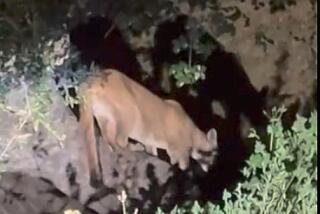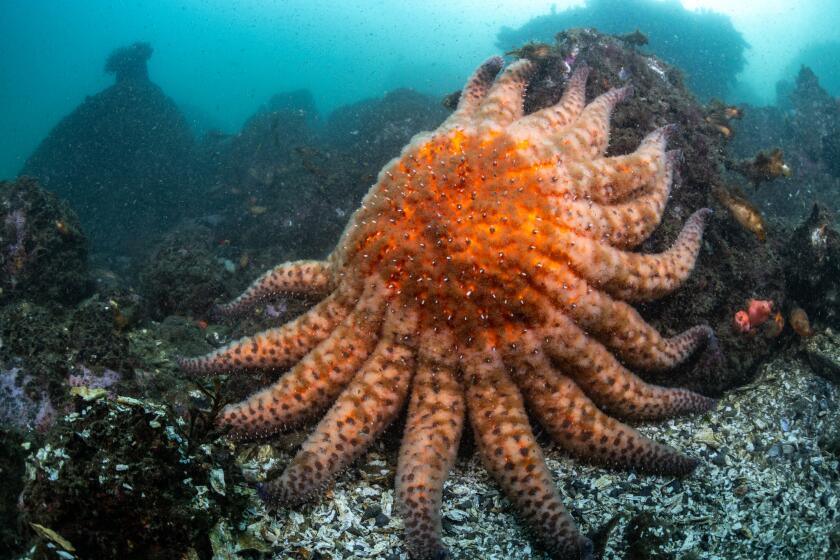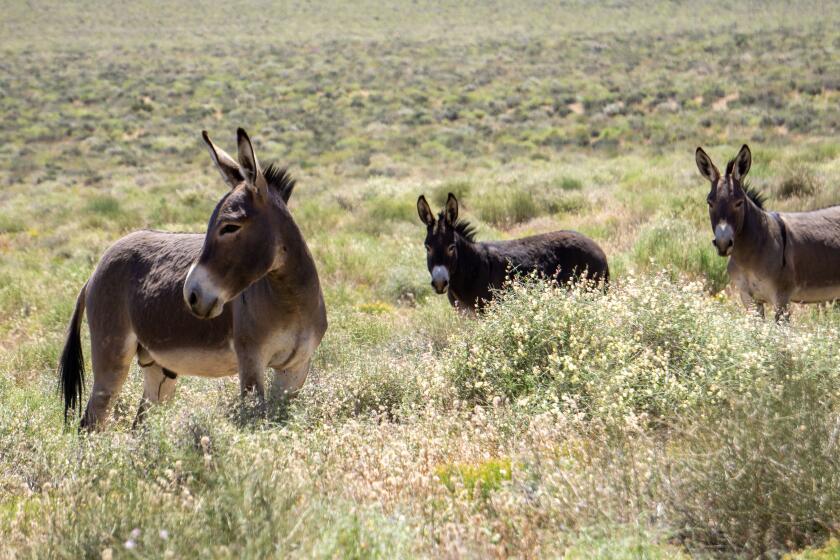Frank Craighead, 85; Studied Grizzly Bears
- Share via
Frank Craighead Jr., a scientist who pioneered the first comprehensive field studies of the fearsome grizzly bear, has died. He was 85.
Craighead died Oct. 21 at a hospital in Jackson, Wyo., after a long struggle with Parkinson’s disease.
Known as one of the nation’s most versatile naturalists, Craighead wrote six books, ranging from a popular Rocky Mountains wildflower guide to a survival manual for naval aviators trapped behind enemy lines. Along with his twin brother, John, of Missoula, Mont., he was also one of the principal architects of the Wild and Scenic Rivers Act, signed into law in 1968.
He also founded the Craighead Environmental Research Institute in 1955, which today has offices in Bozeman, Mont., and Moose, Wyo., and continues to pursue the protection and study of wildlife and wilderness.
But Frank Craighead will be remembered most for his contribution to a large body of work on Ursus arctos horribilis, the scientific name for the largest carnivore in the 48 contiguous states, the grizzly bear.
Beginning in 1959, the Craigheads began relentlessly tracking grizzlies in Yellowstone National Park. At the time, the bears had been hunted to extinction in most Western states--including California--and knowledge of their habits and biology amounted to little more than folklore.
Over the next 12 years, the Craigheads proved that the aggressive and reclusive animals could be studied. The brothers were the first to scientifically describe grizzlies’ diets, mating habits and use of different habitats. To track bears, they invented the radio collar, a device that revolutionized the study of hundreds of species.
“It was all brand new,” said Chuck Schwartz, the leader of the Interagency Grizzly Bear Study Team, a combination of federal and state agencies charged with management and study of the bears. “It’s hard to separate Frank and John, because they were a team. They were pioneers not only in the study of bears, but in the science of working with large carnivores. Some of their earliest observations still stand today.”
Born in Washington, D.C., the Craigheads were the sons of a forest entomologist with the Department of Agriculture. As boys, they often traveled into the woods with their father, learning the names of countless insects, flowers, trees and mammals. Frank Craighead would earn an undergraduate science degree from Pennsylvania State University, and a master’s and doctorate in wildlife management from the University of Michigan.
In 1937, the Craigheads began a long association with the National Geographic Society when they walked uninvited into the organization’s Washington headquarters. By the time they left, they had sold a story about their work with hawks.
Their love affair with the northern Rockies blossomed in the late 1930s, when Frank, John and two friends drove cross-country in an old Chevrolet. The brothers found their way to Jackson Hole, Wyo., just south of Yellowstone.
“They fell in love with it,” said Charlie Craighead, the eldest of Frank’s three children. “They loved the big spaces, the fishing, the wildlife, the protected land, that you could take off and backpack in any direction and not see anyone.”
The brothers bought land in the area after World War II. Having heard many of the old woodsmen’s tales about grizzlies, the Craigheads became increasingly intrigued by the lack of knowledge about the bears--and the challenges involved in studying them. By the late 1950s, they had cobbled together funding to begin their landmark study.
“It was a pretty bare-bones operation,” said Charlie Craighead. “We used old trucks, everyone took turns cooking, and once a week we’d have a big fish fry. [Frank] would take me anywhere. We got chased up trees by grizzlies.”
Among the Craigheads’ most impressive findings was learning how to sedate the bears with darts to put radio collars on them. They also found that grizzlies needed an enormous amount of space--which the 2.2-million-acre park couldn’t entirely provide--and that the animals were extremely slow to reproduce, making them especially vulnerable to overhunting outside the park and other human impacts.
Their work was celebrated in a National Geographic television special in the mid-1960s. The program increased awareness of problems facing grizzlies and, in turn, helped fuel one of the nation’s most heated wildlife controversies--with Frank Craighead at its center.
On a single night in August 1967, two women were mauled to death by grizzlies in Glacier National Park in Montana. The incidents occurred miles apart and two different bears--both of which had become accustomed to eating human food--were found to be responsible. “It was one of those coincidences that just can’t happen but did,” said Chuck Jonkel, a longtime wildlife biologist in Missoula.
The National Park Service, worried about the safety of visitors, responded quickly. A 1963 report by biologist A. Starker Leopold had urged a return to natural conditions in the parks. The park service decided the best way to accomplish that was to close the garbage dumps where many grizzlies in Yellowstone were allowed to feed.
The Craigheads argued that closing the dumps too quickly would result in more dangerous encounters between grizzlies and people, because the bears would search for easily accessible sources of food. Nevertheless, in 1970, the park closed the last dump to bears and over the next two years, at least 88 bears were killed in or near the park--some by rangers, others by hunters. Frank Craighead publicly accused the park of covering up the deaths--a charge never proved--and said the region’s shrinking bear population could not sustain such a loss.
The dispute boiled over in 1971, when the Craigheads abruptly ended their work in Yellowstone after refusing the park service’s demands to edit their findings before they were made public. The conflict made national headlines and was stirred again by Frank Craighead’s 1979 book, “Track of the Grizzly.”
Grizzlies were listed as threatened under the Endangered Species Act in 1975, and the designation remains in effect today. Many of the Craigheads’ recommendations have been followed, and grizzly populations are believed to have grown in recent years, although the numbers are still intensely debated.
In May, the Craigheads received an award for their contributions to science from their old nemesis, the Department of the Interior, which oversees the park service. The award was given to them in Jackson at a gathering of bear researchers from across the globe, many of whom have said they chose their line of work after watching the Craigheads on TV. Frank Craighead, although ill, attended.
“Frank helped bring the natural world into people’s living rooms and he helped develop the idea that big predators had a role in the natural world,” said Louisa Willcox of the Sierra Club. “He made Yellowstone come alive and made people realize the grizzlies were really the heart of our Western wildlands and that if they go, so goes a part of our soul.”
In addition to his son, Charlie, Craighead is survived by his wife, Shirley; son, Lance; daughter, Jana Smith; and brother, John.
A memorial service is expected to be held in November. Donations can be sent to St. John’s Medical Center, P.O. Box 428, Jackson, WY 83001.
More to Read
Sign up for Essential California
The most important California stories and recommendations in your inbox every morning.
You may occasionally receive promotional content from the Los Angeles Times.










